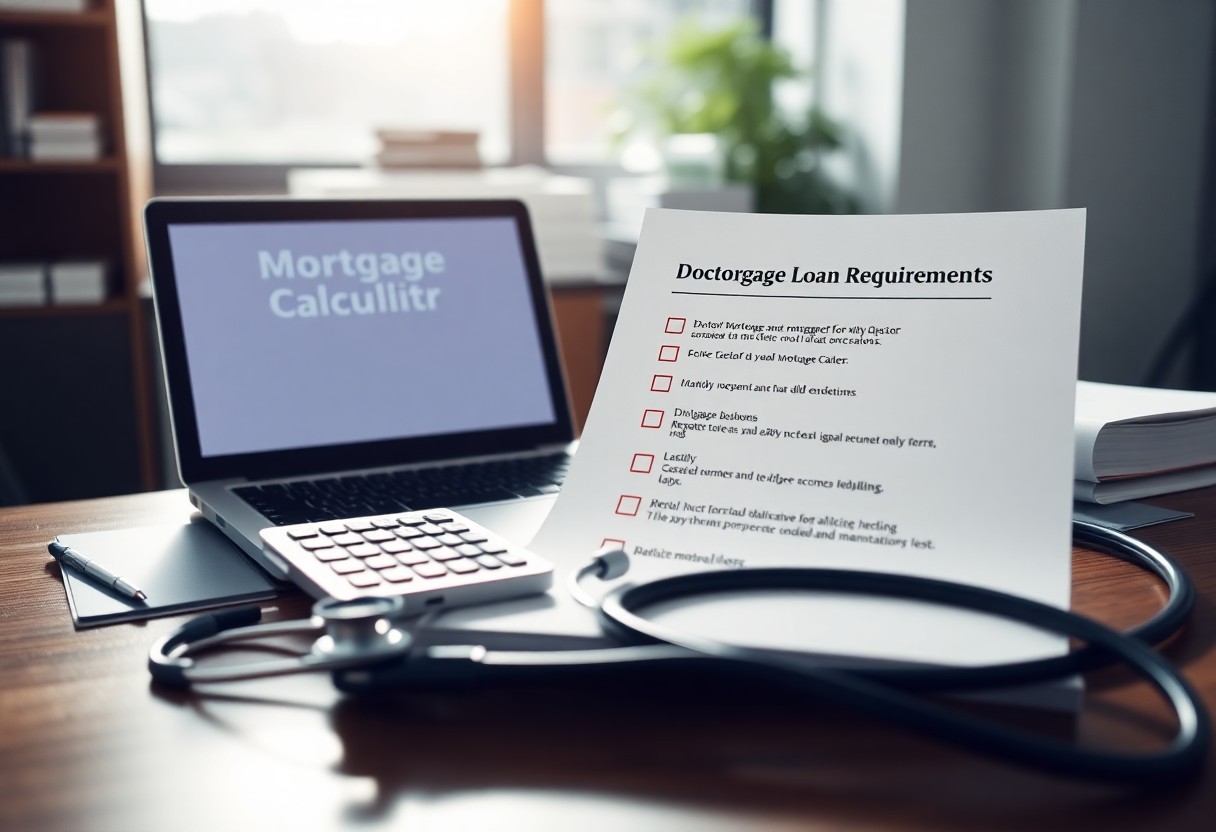Physician loans offer unique opportunities for medical professionals like you looking to navigate the complex world of homeownership. These specialized mortgage options often come with benefits such as lower down payment requirements and favorable terms. However, before exploring into this financial commitment, it’s important to weigh the pros and cons. In this blog post, you will uncover key insights about physician loans, helping you make an informed decision that aligns with your financial goals and lifestyle.

The Unique Financial Landscape of Physician Loans
Understanding the nuances of physician loans reveals a financial environment tailored to the specific needs of medical professionals. These loans often cater to newly graduated doctors and physicians still in residency, allowing them to secure funding without the burden of extensive financial history or significant down payments. Rather than adhering to standard mortgage requirements, the unique structure of physician loans accommodates your unique financial trajectory, providing a pathway to homeownership that traditional lenders may overlook.
How Physician Loans Differ from Conventional Mortgages
Physician loans stand out from conventional mortgages primarily due to their tailored requirements. Unlike traditional loans that weigh heavily on credit scores, income verification, and down payment amounts, physician loans recognize the unique circumstances of doctors. Lenders are more likely to overlook student loan debt and allow for low or even no down payment options, facilitating homeownership at a critical stage in your career.
Key Features: No PMI and 100% Financing
One of the most appealing aspects of physician loans is the elimination of Private Mortgage Insurance (PMI) and the option for 100% financing. This means you can secure your home without the added expense of PMI, which can significantly reduce your monthly payments. With the ability to finance your home in full, you can keep your savings intact, making it easier to navigate any unexpected financial obligations that may arise in the early years of your medical career.
- No PMI or other private mortgage insurance fees
- Financing options up to 100%
- Flexible debt-to-income ratio calculations
- Less stringent credit score requirements
- Ability to qualify with student loans considered as deferred
After understanding these key features, you will appreciate how physician loans streamline homeownership, alleviating the financial strain during a pivotal stage in your career.
Exploring the “No PMI and 100% Financing” feature further, this advantage makes a significant difference in your budget. Having no PMI allows you to maximize the funds available for your home purchase, effectively freeing up cash for potential renovations or future investments. Additionally, the ability to finance the entire purchase price means that many physicians can enter the housing market sooner than they might have anticipated—making homeownership a reality even during the early years when finances may be tight.
- No additional costs from PMI
- Allows you to purchase sooner with little to no down payment
- Keep cash reserves available for other expenses
- Easier to navigate high-cost housing markets
- Increased access to more desirable property locations
After reviewing these features, you can see how they not only promote financial freedom but also provide a strategic advantage in achieving homeownership earlier in your career.
The Attractive Benefits of Choosing Physician Loans
Physician loans offer unique advantages tailored to meet the financial needs of medical professionals. These specialized mortgage programs often allow you to secure financing with reduced down payment requirements and minimal restrictions. With understanding lenders familiar with the nuances of your profession, you’re positioned to make homeownership more accessible, enabling you to focus on your career and personal life rather than overwhelming financial hurdles.
Lower Barriers to Entry for Homeownership
The lower barriers to entry associated with physician loans significantly ease your path to purchasing a home. Many standard mortgage options require substantial down payments, often ranging from 5% to 20%. Conversely, certain physician loan programs allow for 0% to 10% down, allowing you to preserve your savings for other financial commitments or investments. This feature can be particularly beneficial for residents and newly graduated physicians with high student debt but limited cash reserves.
Favorable Interest Rates in a Competitive Market
With physician loans, you often encounter more favorable interest rates compared to conventional mortgages. Lenders recognize the earning potential and job stability of medical professionals, offering reduced rates that can translate to significant savings over the life of the loan. In a competitive market where rates fluctuate, you might find these loans providing advantageous terms that enhance your buying power while keeping monthly payments manageable.
For instance, while conventional loans may range from 3.5% to 4.5% interest, a well-structured physician loan could offer rates closer to 3%. Over a 30-year mortgage, this difference can save you tens of thousands of dollars in interest payments. Additionally, some lenders do not charge private mortgage insurance (PMI) on their physician loans, further lowering your overall cost. By capitalizing on these favorable rates, you can invest those savings into home improvements or contribute towards your future financial goals without the burden of excessive debt.
The Potential Pitfalls of Physician Loans
While physician loans come with notable benefits, they also have drawbacks that require careful consideration. As a medical professional, you need to weigh these potential pitfalls against the appealing facets of these loans to truly understand their implications on your financial future.
Hidden Costs and Fees You Might Overlook
Even though physician loans typically offer lower down payment options, they can be obscured by hidden costs and fees. These may include higher interest rates compared to conventional loans, origination fees, and possibly even private mortgage insurance (PMI) depending on the lender. An initial attractive loan offer can quickly morph into a costly arrangement if you’re not vigilant about these additional expenses.
The Risks of Underestimating Future Financial Commitments
Overlooking the future financial obligations that come with a physician loan can be a costly mistake. Medical professionals often face salary fluctuations, particularly during residency or fellowship years, leading to potential cash flow issues. If you do not accurately assess your future expenses—like student loans, family obligations, and lifestyle choices—your financial landscape could become strained, making loan repayment and home ownership less sustainable.
As a physician, you are likely juggling a myriad of financial responsibilities, from student loan debt to personal expenses. Many physicians might assume their income will consistently rise, yet unexpected life changes, shifts in practice, or market downturns can alter your financial trajectory. Evaluating your future earning potential realistically, including possible job transitions or market volatility, allows you to establish a more secure framework for homeownership. Always account for the long-term—this includes estimating aspects like healthcare expenses, children’s education, and retirement savings, which can impact your financial health over time.
Real-Life Experiences: Voices from the Field
Stories from those who have walked the path of homeownership through physician loans bring valuable insights that numbers alone cannot convey. From physicians securing their first homes to established doctors navigating refinancing, the narratives highlight the challenges and triumphs experienced in the journey. Hearing firsthand how peers tackled financial dilemmas and leveraged their unique loan benefits can provide you with the real-world context needed to make informed decisions on your home-buying adventure.
Successful Homeowners: Navigating the Process
Physicians who successfully navigated the home-buying process often emphasize the importance of understanding lender requirements and market conditions. One doctor shared how utilizing their physician loan allowed for minimal down payment, which was crucial in maintaining liquidity for unexpected expenses. By staying informed and networking with fellow medical professionals, you can uncover strategies and insights that contribute to that success.
Cautionary Tales: Learning from Mistakes
While many have benefited from physician loans, some faced pitfalls that serve as valuable lessons. Miscalculating the affordability of homes or neglecting to account for future career moves led to regrettable situations. One tale involved a resident who bought a home in an area that became increasingly undesirable. Their struggle to sell it later highlighted the necessity of researching neighborhoods thoroughly before making any investment.
The cautionary tales of those who have made mistakes in their home-buying journey often underscore common pitfalls. For example, one physician purchased a property based solely on current market trends, ignoring the potential for future changes in their family and professional life. When work demanded relocation, they found themselves juggling a home they couldn’t sell easily. Learning from these experiences emphasizes the importance of considering not only the current market but also personal and professional trajectories before committing to homeownership, ensuring your investment aligns with your long-term goals.
Making an Informed Decision: Is a Physician Loan Right for You?
Determining whether a physician loan is suitable for your financial landscape requires careful consideration of some key factors, including your career stage, financial health, and long-term goals. Understanding the terms of a physician loan alongside your personal circumstances can lead you to a choice that aligns with your aspirations of homeownership while also ensuring financial stability.
Personal Financial Health: Assessing Your Situation
Before committing to a physician loan, evaluate your financial health by examining your income, existing debt, credit score, and savings. Assessing these elements will give you a clearer picture of your borrowing power and your ability to comfortably manage monthly mortgage payments. If you’re in the early years of your medical career, take note of expected salary growth and upcoming expenses that may impact your financial stability.
Alternative Financing Options to Consider
While physician loans offer unique benefits, considering alternative financing options can help you find a deal that better suits your needs. Conventional loans, FHA loans, or even USDA loans could provide lower interest rates and more favorable terms, especially if you have a significant down payment saved. These options might come with private mortgage insurance (PMI) costs, but their overall financial impact can be lower than a physician loan, especially if you qualify for favorable interest rates based on your creditworthiness or if you plan on staying in one location long-term.
Additionally, exploring first-time homebuyer programs might yield grants or financial assistance which can significantly lower your initial costs. In some cases, your employer may even offer housing assistance or relocation stipends for new physicians. Weighing all these financing possibilities allows you to select the one that aligns best with your financial goals and personal circumstances, ensuring a solid foundation for your journey into homeownership.
Conclusion
From above, you can see that physician loans offer unique benefits and challenges that can significantly impact your journey to homeownership. By understanding the advantages, such as low or no down payment options and flexible credit requirements, alongside the potential drawbacks, including higher interest rates and limited lender options, you can make a more informed decision that aligns with your financial goals. As you navigate this process, weigh these factors carefully to determine if a physician loan is the right choice for your future home.




